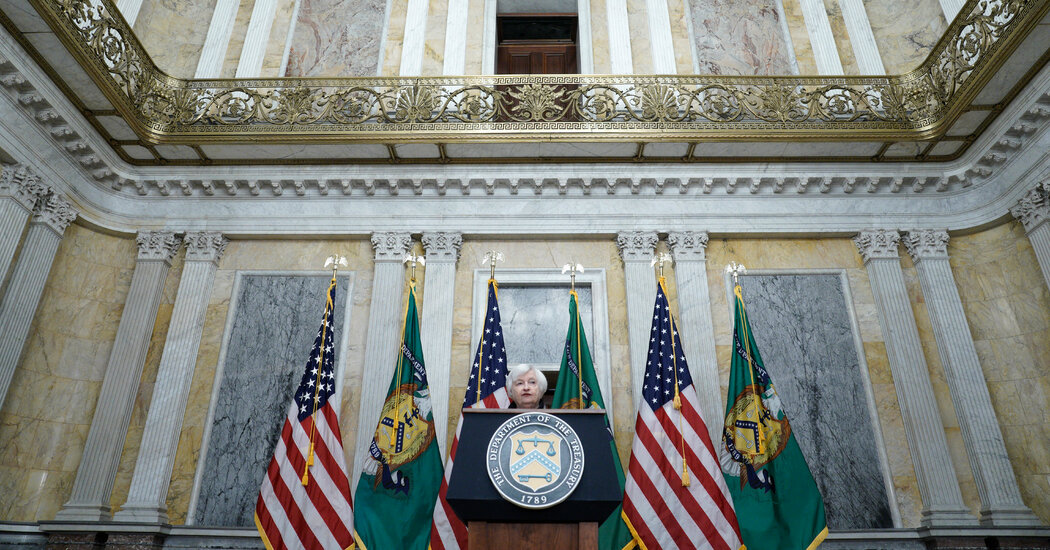The wrangling over the nation’s debt limit raises a lot of questions, including what it actually is and why the United States has one.
Here’s everything you need to know.
What is the debt limit?
The debt limit is a cap on the total amount of money that the United States is authorized to borrow to fund the government and meet its financial obligations.
Because the federal government runs budget deficits — meaning it spends more than it brings in through taxes and other revenue — it must borrow huge sums of money to pay its bills. Those obligations include funding for social safety net programs, interest on the national debt and salaries for members of the armed forces.
Approaching the debt ceiling often elicits calls by lawmakers to cut back on government spending. But lifting the debt limit does not actually authorize any new spending — in fact, it simply allows the United States to spend money on programs that have already been authorized by Congress.
When was the debt limit reached?
The United States officially hit its debt limit on Jan. 19, prompting the Treasury Department to use accounting maneuvers known as extraordinary measures to continue paying the government’s obligations and avoid a default. Those measures temporarily curb certain government investments so that the bills can continue to be paid.
Treasury Secretary Janet L. Yellen has warned lawmakers that the United States could run out of cash in early June if the borrowing cap isn’t raised or suspended.
How much debt does the United States have?
The national debt crossed $31 trillion for the first time last year. The borrowing cap is set at $31.381 trillion.
Why does the United States have a debt limit?
According to the Constitution, Congress must authorize government borrowing. In the early 20th century, the debt limit was instituted so that the Treasury would not need to ask Congress for permission each time it had to issue debt to pay bills.
During World War I, Congress passed the Second Liberty Bond Act of 1917 to give the Treasury more flexibility to issue debt and manage federal finances. The debt limit started to take its current shape in 1939, when Congress consolidated different limits that had been set on different types of bonds into a single borrowing cap. At the time, the limit was set to $45 billion.
While the debt limit was created to make government run more smoothly, many policymakers believe that it has become more trouble than it’s worth. In 2021, Ms. Yellen said she supported abolishing the debt limit.
What happens if the debt limit is not raised or suspended?
If the government exhausts its extraordinary measures and runs out of cash, it would be unable to issue new debt. That means it would not have enough money to pay its bills, including interest and other payments it owes to bondholders, military salaries and benefits to retirees.
No one knows exactly what would happen if the United States gets to that point, but the government could default on its debt if it is unable to make required payments to its bondholders. Economists and Wall Street analysts warn that such a scenario would be economically devastating, and could plunge the entire world into a financial crisis.
Will military salaries, Social Security benefits and bondholders be paid?
Various ideas have been raised to ensure that critical payments are not missed — particularly payments to the investors who hold U.S. debt. But none of these ideas have ever been tried, and it remains unclear whether the government could actually continue paying any of its bills if it can’t borrow more money.
One idea that has been proposed is that the Treasury Department would prioritize certain payments to avoid defaulting on U.S. debt. In that case, the Treasury would first pay the bondholders who own U.S. Treasury debt, even if it delayed other financial obligations like government salaries or retirement benefits.
So far, the Treasury seems to have ruled that out as an option. Ms. Yellen has said that such an approach would not avoid a debt “default” in the eyes of markets.
“Treasury systems have all been built to pay all of our bills when they’re due and on time, and not to prioritize one form of spending over another,” Ms. Yellen told reporters earlier this year.

